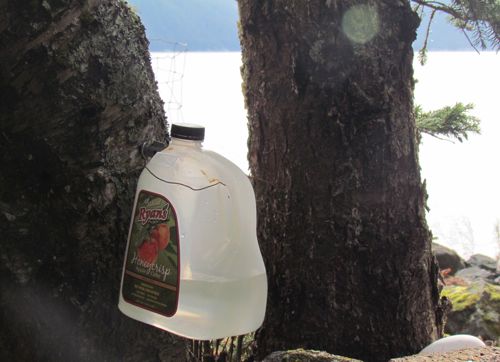Even though revamping our power system holds the bulk of my attention and activity lately (see Power Shift: A New/Old Battery Bank) other tasks, especially those that are seasonally sensitive, occupy me.
Birch tapping season recently returned to the “homestead”. However, informed by new advice, that season shifted somewhat this year.
In past years, we tapped our local birch successfully following advice from various sources (see, for example, The First of the Cabin Wines). Several weeks ago, I saw our tapping window open, and prepared my tools. The day I planned to drill the first tap hole, Michelle sent me an Internet article that changed everything.
The article, from the blog Farming the Woods, covered tapping a variety of trees, including maple, birch, and walnut. I found this article particularly valuable because, unlike so many other sources we’ve found, it describes the differences between tapping methods and practices for maples and for birches.
Apparently, our older sources lumped together the tapping of these two different trees. The new article stressed that while the two processes are complementary, they differ in key respects.
Most significantly, the article points to what triggers sap rise in each tree. Maples respond to stem pressure, which comes from dramatic temperature changes between day and night. Birches respond to root pressure, triggered by temperatures stabilizing above freezing.
In the past, I followed the older source recommendations, and tried to tap our birches as if they were maples. This proved tricky in our Southeast Alaskan springs with their very volatile temperature swings. This also explains why, once I started tapping, I found the flow more copious after the local temperatures stabilized. I noticed this, but failed to grasp its significance (see “Moonshine”).
The article also contained important information on how to tap trees and recommendations for storing sap. It also explained the health benefits of drinking birch sap.
Now, a few weeks later than planned, we’re drinking fruit juic concentrate made with birch sap instead of plain water, and I’ve started a few batches of birch wine fermenting. Looks like it’ll be a good season, if it’s slightly later than we expected.


Woo! Info score! Tip a glass o’ that our way! 8) Dave Z
PS… have you run across anybody tapping alder?
Dave, no. Aly said that you talked about that with her, but the article I mention claimed to list all the tappable trees. Alder wasn’t one of them. Of course, as you know, a lot of people regard alder as a bush rather than a tree, so maybe they are in that camp?